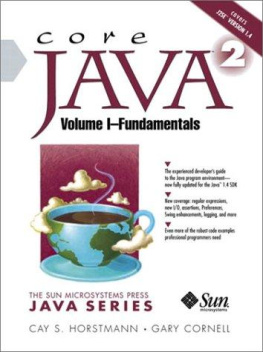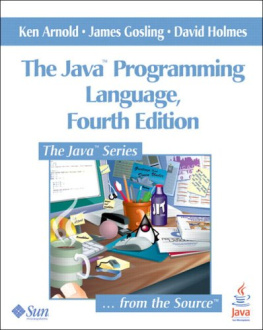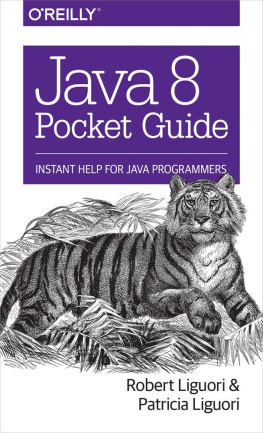Cay Horstmann - Core Java 2, Volume I: Fundamentals
Here you can read online Cay Horstmann - Core Java 2, Volume I: Fundamentals full text of the book (entire story) in english for free. Download pdf and epub, get meaning, cover and reviews about this ebook. year: 2002, publisher: Prentice Hall PTR, genre: Computer. Description of the work, (preface) as well as reviews are available. Best literature library LitArk.com created for fans of good reading and offers a wide selection of genres:
Romance novel
Science fiction
Adventure
Detective
Science
History
Home and family
Prose
Art
Politics
Computer
Non-fiction
Religion
Business
Children
Humor
Choose a favorite category and find really read worthwhile books. Enjoy immersion in the world of imagination, feel the emotions of the characters or learn something new for yourself, make an fascinating discovery.
- Book:Core Java 2, Volume I: Fundamentals
- Author:
- Publisher:Prentice Hall PTR
- Genre:
- Year:2002
- Rating:4 / 5
- Favourites:Add to favourites
- Your mark:
Core Java 2, Volume I: Fundamentals: summary, description and annotation
We offer to read an annotation, description, summary or preface (depends on what the author of the book "Core Java 2, Volume I: Fundamentals" wrote himself). If you haven't found the necessary information about the book — write in the comments, we will try to find it.
Completely revised and up-to-date coverage of
- Generic programming, restrictions and limitations, type bounds, wilcard types, and generic reflection
- Swing GUI development, including input validation and other enhancements
- Exception handling and debugging, including chained exceptions, stack frames, assertions, and logging
- Streams and files, the new I/O API, memory-mapped files, file locking, and character set encoders/decoders
- Regular expressions using the powerful java.util.regex package
- Inner classes, reflection, and dynamic proxies
- Application packaging and the Preferences API
The seventh edition of Core Java 2, Volume I, covers the fundamentals of the Java 2 Platform, Standard Edition (J2SE). A no-nonsense tutorial and reliable reference, this book features thoroughly tested real-world examples. The most important language and library features are demonstrated with deliberately simple sample programs, but they arent fake and they dont cut corners. More importantly, all of the programs have been updated for J2SE 5.0 and should make good starting points for your own code. You wont find any toy examples here. This is a book for programmers who want to write real code to solve real problems.
Volume I concentrates on the fundamental concepts of the Java language, along with the basics of user-interface programming and provides detailed coverage of
- Object-oriented programming
- Reflection and proxies
- Interfaces and inner classes
- The event listener model
- Graphical user-interface design with the Swing UI toolkit
- Exception handling
- Stream input/output and object serialization
- Generic programming
For the same real-world treatment of enterprise features and advanced user-interface programming, look for the forthcoming new edition of Core Java 2, Volume IIAdvanced Features.
It includes new sections on metadata and other J2SE 5.0 enhancements along with complete coverage of: Multithreading Distributed objects Databases Advanced GUI components Native methods XML Processing Network programming Collection classes Advanced graphics Internationalization JavaBeans
Cay Horstmann: author's other books
Who wrote Core Java 2, Volume I: Fundamentals? Find out the surname, the name of the author of the book and a list of all author's works by series.







